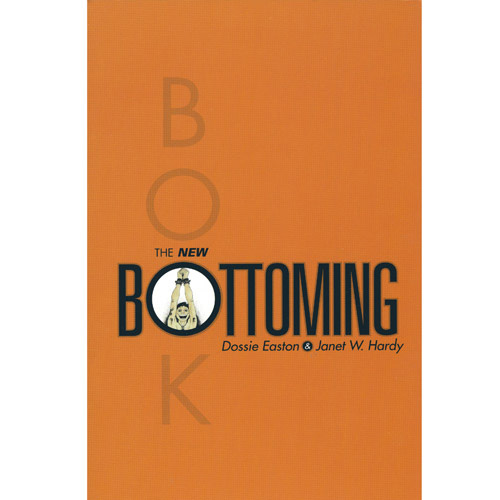The New Bottoming Book raises a stern tone for those who think Lifestyle Players have to adhere to predetermined activities or stereotypes, of who are “really” Subs, Doms, Tops, Bottoms etc, and try to eliminate some of the inherent Elitism in some BDSM subcultures where rules of identity are strict and who “is” or who “isn’t” “doing it right” are called out. They let us know that if one believes one is a particular role, than that is all that is necessary. Quote “Nobody else gets to vote, even though (someone else’s sexuality) may or may not look different than yours, they do not get a vote or get to devalue or change what you like to do.” (italics mine ) This is a freeing and very accepting tone, and it sets the entire book.
They talk about the absolute need for full consent, knowing what you are getting into, talking Scenes out ahead of time (if that’s the way you and your chosen partner work) learning how to let a prospective partner know where YOUR hard boundaries are. Even making lists of “Yes” (want to do) “No” (will not do, in any aspect) and “maybe” (depending on mood, scene and partner or for further exploration.) are suggested to be discussed with one’s Top, to avoid unpleasant surprises and to make Scenes and actions go much more smoothly. The Top is also encouraged to make up the same lists, so you will be on the same page.
Although the book is short a lot is included in it. Negotiating, when to do it, is stressed as important (after all, a Bottom needs caring and pleasure, too, that’s why we do it.) Whether and when to include actual Sex in a Scene is gone into. Some people need it, others wait until later or with different partners. How to never go along with an act ONLY to please a Top (some Bottoms may take issue with this) but the authors are more interested in being True to Oneself than selfless Service. Not that Service isn’t covered, but it is in terms as part of Negotiation. Quote “If you can’t Negotiate a Scene honestly, then you need not play.” I couldn’t agree more. Some may take exception to this, but the book covers Consent of Force in other ways. They talk about the fact of having no shame in having and using a Safeword and avoiding Tops who either try to admonish you for using it, or want to play without one. And the fact that one of the Responsibilities of a Top is to give Support and Affection when a Bottom needs to call Safeword, not to mock or cajole. They also talk about the fact that sometimes, Tops may need to Safeword Out, and that there is no shame in this.
They go into the Power of a Bottom and the sometime fragility and sensitivity of a Top; we are all, after all, all human. The authors give several unapologetic examples of their own use of use of Safewords.
Check Ins are discussed (The Top making sure, with speech or gestures that the Bottom is OK) and Aftercare is touched on, although, as this is a psychologically oriented book, I wish Aftercare had been gone into in more detail.
Catharsis and Spiritual States (some going briefly into Tantric Sex Magic) is briefly covered, and for many, it is the reason they seek out either side of Power Play. They warn to be aware that Catharsis may occur without warning or may surprise you, and you Top needs to be aware of this and support you, while you need to know when to go with the flow and when something is so intense and psychically painful that it would better be handled in Therapy.
Amazing “SubSpace” trippy, high near leaving one’s body states are also covered, which can happen in either role, but are of course, covered in more detail for the Bottom in this book. This alone is worth the price of the book. Some may be blown away at the Altered States that Intense Sensation Play can bring, and this book can at least in part explain why and how to enjoy it, and why your Top sometimes needs to bring you back down to Earth. You may have times where you don’t want to leave SubSpace.
Bondage, Sensory Deprivation, Dominance and Submission and Service and Discipline, Reward and Punishment are, of course, all discussed from both a new players viewpoint, as well as the psychological aspects of such acts. Although some vignettes from the authors own Play experiences are given as examples, these pages are not full “How to” instructions. They do assume you have already made up your mind to enter into a D/S or BDSM Space, and intricate instructions and all but the most basic safety warnings are not included.
The book also outlines how most scenes, particularly when new to this type of play or with an unfamiliar partner, are not going to be the “Perfect Scene” you may have been fantasizing about for a long time. After all, we are all human, and many fantasies disregard not only the laws of physics, but natural human behavior and emotions. (You are reminded Top is human, too.)
Whips, floggings, Body Modification, either permanent or temporary are discussed as are different types of Bottoms and Tops and their possible motivations. Discussions of “Surfing the Pain” may be an introduction for some readers, or come as second nature to others, but it is covered and wouldn’t be complete without it.
Role Playing, Authority Scenes (who doesn’t like a nice, adult game of Cop and Prisoner?) and Gender Play are all covered. These are the Bread and Butter of many people’s Play Life. Regression and Age Play is also covered, with some warnings and caveats. I find that perhaps not enough warnings for this type of play were covered, but that could be my own bias showing through. (I personally find Regression Play terrifying, and unpleasant and is on my “NO” list at all times.) The authors do say “Nowhere is it more important to know your limits than in regression play, and nowhere is it more challenging.” No kidding. They do mention bringing these issues into therapy, instead of the Dungeon for some, and it is the best advice for many.
They also touch on other common Play Genres, “Beasties” (also known now days as Furries) Humiliation and “Verbal Abuse” (although I prefer the term “Dirty Talk” myself) and the often Verboten “Cultural Trauma.” (Things like Antebellum Master Slave scenes, or history heavy Interrogation Scenes.)
They, and with good reason, talk about Public Play and the issue of NonConsent of bystanders, and suggest Public Play is best (and most legally) incorporated and acted out during Play Parties, rather than in actual Public.
 im definitely a switch so this book may be good for me
im definitely a switch so this book may be good for me Great review!!!
Great review!!! Good review another book for me to read
Good review another book for me to read




